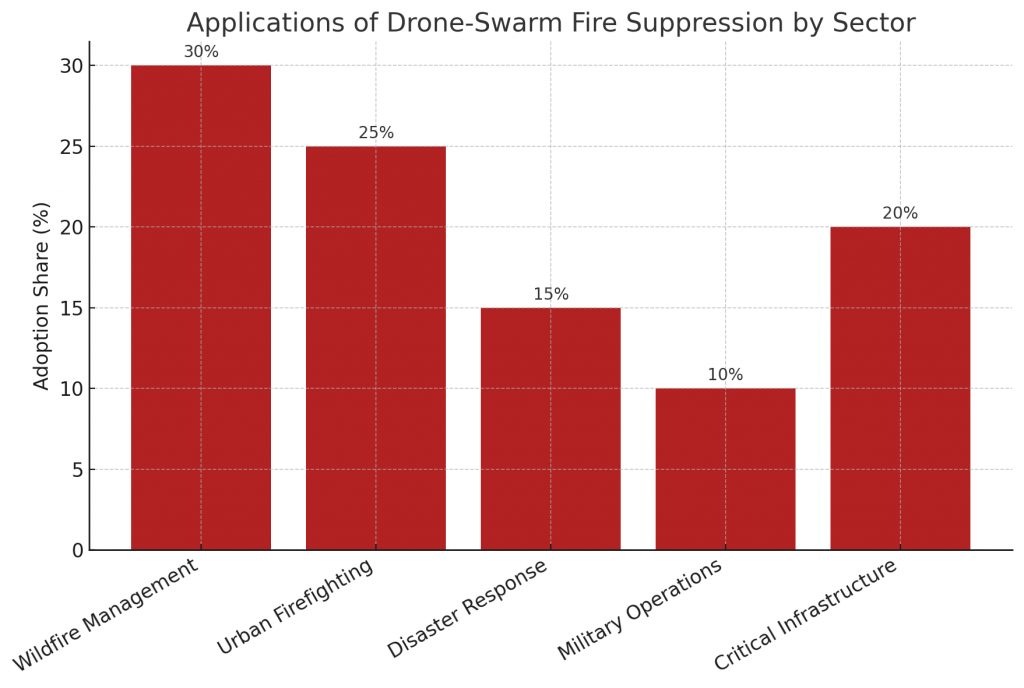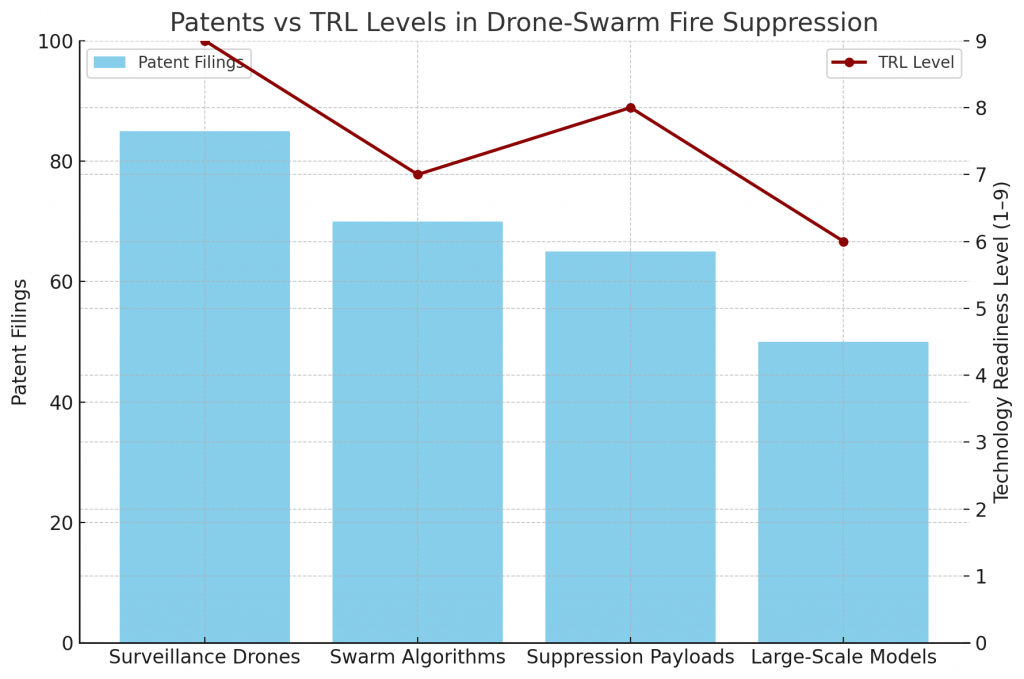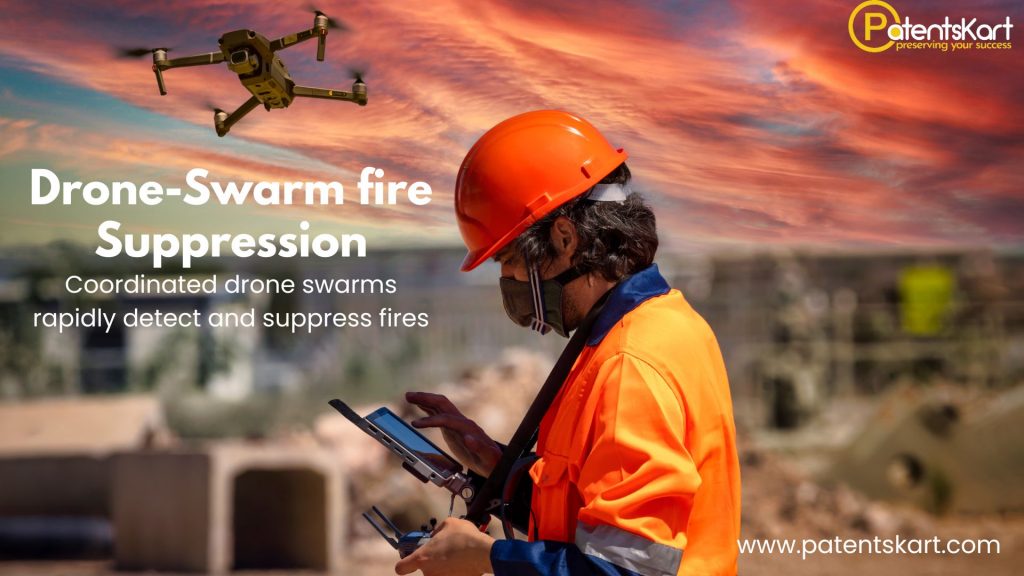Wildfires, industrial accidents, and urban blazes are becoming increasingly difficult to manage with traditional firefighting methods. Rising global temperatures and expanding urbanization demand innovative solutions for fire control. One such innovation is drone-swarm fire suppression, a system that uses fleets of autonomous drones coordinated by artificial intelligence to combat fires efficiently, safely, and at scale.
By integrating swarm intelligence, thermal imaging, and aerial robotics, drone-swarm fire suppression has the potential to redefine firefighting strategies and support emergency responders across diverse environments.
What Is Drone-Swarm Fire Suppression?
Drone-swarm fire suppression refers to the coordinated use of multiple autonomous drones working in unison to detect, monitor, and extinguish fires. Unlike a single drone, a swarm functions like a collective organism, where drones communicate and adjust strategies dynamically.
Core features include:
- Swarm AI: Enables decentralized decision-making and adaptability.
- Thermal sensors: Detect heat sources and track fire spread.
- Payload systems: Carry extinguishing agents such as water, foam, or fire retardants.
- Autonomous navigation: Operate without direct human piloting in hazardous zones.
- Scalability: Deploy dozens or hundreds of drones simultaneously.
This innovation brings agility, precision, and safety to firefighting.
Why Is Drone-Swarm Fire Suppression Important?
The significance of drone-swarm fire suppression lies in addressing critical challenges:
- Safety: Reduces risks to human firefighters in hazardous zones.
- Speed: Rapid deployment in remote or inaccessible areas.
- Efficiency: Coordinates resources intelligently for maximum impact.
- Scalability: Adapts to fires of different sizes and intensities.
- Data collection: Provides real-time situational awareness for command centers.
This makes it a vital technology in the era of climate-induced wildfires.
How Does Drone-Swarm Fire Suppression Work?
The functioning of drone-swarm fire suppression integrates robotics, AI, and firefighting methods:
- Step 1: Detection – Drones equipped with infrared and thermal cameras identify fire hotspots.
- Step 2: Communication – Swarm drones exchange data through mesh networks.
- Step 3: Coordination – AI algorithms assign tasks like surveillance, fire retardant spraying, or supply delivery.
- Step 4: Suppression – Payload-equipped drones release extinguishing agents.
- Step 5: Monitoring – Swarm provides continuous real-time updates on fire behavior.
This layered system ensures adaptive and effective fire control.
What Are the Benefits of Drone-Swarm Fire Suppression?
Key advantages include:
- Reduced risk: Keeps human firefighters away from dangerous environments.
- 24/7 operation: Night-time and low-visibility firefighting using sensors.
- Cost savings: Less manpower and equipment required over time.
- Precision targeting: Direct suppression at fire hotspots.
- Environmental protection: Minimizes collateral damage to ecosystems.
Drone-swarm fire suppression offers both operational and environmental benefits.
What Are the Applications of Drone-Swarm Fire Suppression?
Applications extend across multiple domains:
- Wildfire management: Rapid containment of forest fires.
- Urban firefighting: High-rise and industrial complex protection.
- Disaster management: Support during earthquakes or explosions.
- Military operations: Protecting bases and equipment.
- Critical infrastructure: Safeguarding power plants, oil refineries, and data centers.

This range shows the technology’s versatility.
Which Companies Are Leading in Drone-Swarm Fire Suppression?
Global leaders are advancing this technology:
- DJI: Developing drone hardware with firefighting payloads.
- Lockheed Martin: Defense-grade swarm robotics systems.
- Aerones: Heavy-lift drones for aerial fire suppression.
- Elistair: Tethered drones for long-duration operations.
- Skydio: AI-driven autonomous drones for real-time response.
These leaders validate the industrial and defense applications of drone-swarm fire suppression.
Which Startups Are Innovating Rapidly?
Startups are pushing agility and creative applications:
- Parallel Flight Technologies: Heavy-lift firefighting drones.
- Drone Amplified: Fire suppression payloads for wildfire management.
- Robotics Cats: AI fire detection using drones.
- Volansi: Autonomous logistics support in fire zones.
- Fotokite: Persistent tethered drones for monitoring.
They accelerate adoption across public safety and environmental protection.
What Do Patents and TRL Levels Indicate?
Patent activity shows innovation in:
- Autonomous swarm algorithms.
- Fire suppression payload systems.
- Thermal imaging integration.
- Drone-to-drone communication networks.
Technology Readiness Levels (TRLs):
- Surveillance drones: TRL 9, fully commercialized.
- Swarm coordination algorithms: TRL 6–8, under testing.
- Fire suppression payloads: TRL 7–8, scaling fast.
- Large-scale deployment models: TRL 5–7, experimental.

This demonstrates both maturity and rapid innovation.
What Are the Challenges in Adoption?
Challenges must be addressed:
- Regulatory barriers: Airspace laws limit swarm deployment.
- Battery limitations: Reduced flight times for heavy payloads.
- Cost of scaling: Expensive hardware and AI systems.
- Reliability: Must function in extreme weather.
- Public acceptance: Trust issues with autonomous systems.
Overcoming these is key to scaling drone-swarm fire suppression worldwide.
What Is the Future Outlook?
The future of drone-swarm fire suppression looks promising:
- Short term (1–5 years): Expanded use in wildfire hotspots.
- Medium term (5–10 years): Integration into smart city safety systems.
- Long term (10+ years): Fully autonomous firefighting swarms globally.
This outlook ensures the technology becomes a mainstream safety tool.
How Can PatentsKart Help?
PatentsKart empowers innovators in drone-swarm fire suppression with:
- Patent landscaping to identify innovation opportunities.
- Competitor benchmarking to monitor global leaders.
- TRL benchmarking to assess readiness.
- Freedom-to-operate studies to reduce risks.
- Commercialization support to accelerate adoption.
This ensures businesses remain ahead in the race for firefighting innovation.
Conclusion
The battle against wildfires and disasters requires more than traditional methods. Drone-swarm fire suppression offers a scalable, intelligent, and safe solution for the future.
By combining robotics, AI, and aerial firefighting, this technology is not just a firefighting tool—it is a transformative approach to global disaster management.
FAQs About Drone-Swarm Fire Suppression
Q1. What is drone-swarm fire suppression?
It is the use of multiple autonomous drones working together to detect and extinguish fires.
Q2. Why is it important?
It reduces firefighter risk, improves efficiency, and enhances real-time data collection.
Q3. Which companies are leading?
DJI, Lockheed Martin, Aerones, Elistair, and Skydio.
Q4. What challenges exist?
Regulatory barriers, battery limits, cost of scaling, and weather resilience.
Q5. How can PatentsKart help innovators?
By providing patent insights, TRL benchmarking, and commercialization strategies.
Q1. What is drone-swarm fire suppression?
It is the use of multiple autonomous drones working together to detect and extinguish fires.
Q2. Why is it important?
It reduces firefighter risk, improves efficiency, and enhances real-time data collection.
Q3. Which companies are leading?
DJI, Lockheed Martin, Aerones, Elistair, and Skydio.
Q4. What challenges exist?
Regulatory barriers, battery limits, cost of scaling, and weather resilience.
Q5. How can PatentsKart help innovators?
By providing patent insights, TRL benchmarking, and commercialization strategies.







